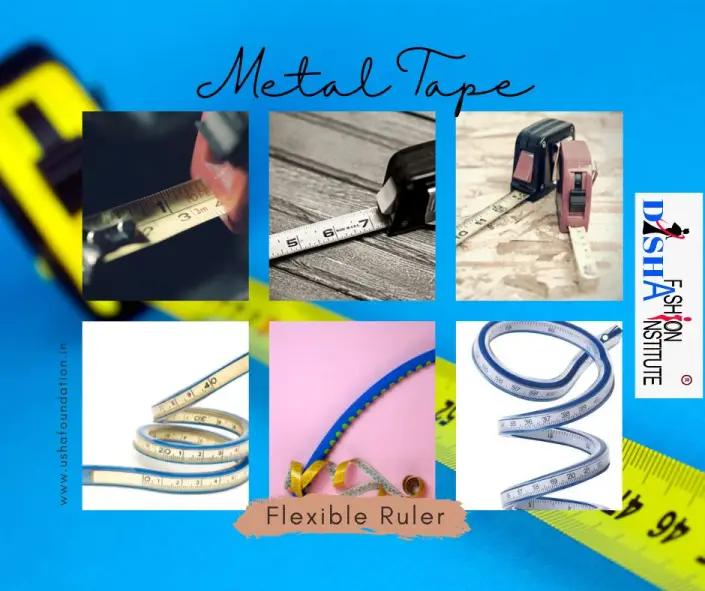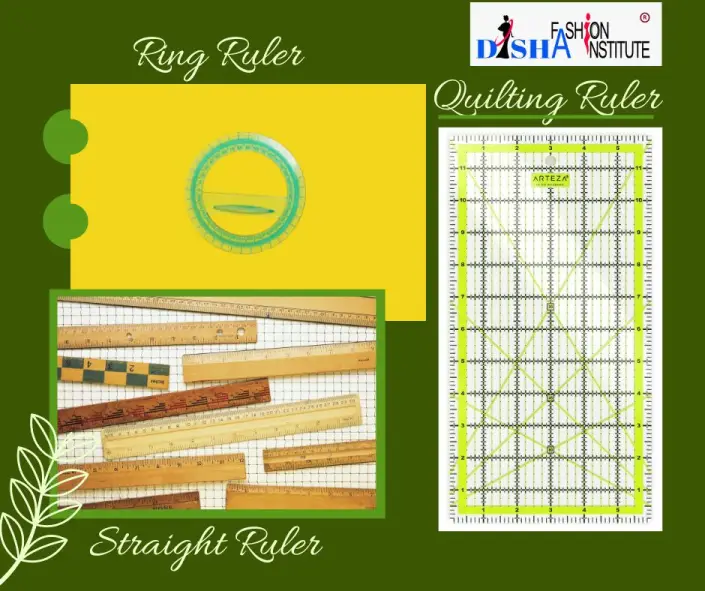Everything You Need to Know About Measuring Tools for Sewing
Sewing is a craft that requires a lot of precision and attention to detail. In order to get the best results, it is important to use the right tools. There are a variety of measuring tools available, and each has its own advantages and disadvantages. In this blog post, we will take a look at some of the different types of measuring tools for sewing, and how to choose the right one for your needs.
Table of Contents

List of Measuring Tools in Sewing
Following are the list of measuring tools in sewing that we will discuss in this blog post.
- Tape Measure
- Extra Long Tape
- Retractable Tape or Flexible Tape
- Flexible Ruler
- Straight Ruler
- Ring Ruler or Ring Scale
- Gridded Ruler or Quilting Ruler
- Clear Ruler
- French Curve
- Sewing Gauge or Seam Gauge
- Yard Stick
- Tailors L square
- Curved Runner
- Cutting Matt
- Arm Curve Ruler
- Hip Curve Ruler
- Leg Curve Ruler
- Arm Hole Curve Ruler
Tape Measure
A measuring tape is an essential tool for any sewer. It is used to take accurate measurements of fabric, pattern pieces, and body measurements. This is the most essential item or measuring tool in your sewing kit. If you have a tape measure, you might not need any other measuring tools. The experienced tailor masters in India who sew dozens of garments every day, rely only on a tape measure when it comes to measurements. All the below mentioned tools are nice to have. But a tape measure is a necessity. A tape measure becomes less accurate over time because of stretches. So it is advisable to change it over time.
The most common tape measure is made of fibre glass. It might have a metal edge, but not always. Buy a tape measure with bold and accurately printed readings that help you take the perfect measurements. Generally a tape measure is 60 inches or 150 cm or 1.5 meter or 5 feet long. One side of the tape contains the metric units and other side contains imperial units.
The tape measure is available with different width. You can consider your tape measure with any width. But I would prefer to use one with the same width as the standard seam allowance i.e. 1.5 cm.
Extra Long Tape
This is usually twice the size of the normal tape measure. It has a length of 300 cm or 10 feet. This is generally required while making soft furnishing. It is also useful to measure the long dresses like a bridal train.

Retractable or Flexible Tape
Retractable tapes are those which retracts automatically. It is a coiled tape, which comes of with a storage. It is such that, when the tape is pulled, it comes out of the housing or the storage and when you leave it, it will automatically wind up into the storage. It contains a metal belt holder at the end of the tape. This is specifically used for the measurements of the furniture. It is easy to carry and as it winds up automatically, makes it easy to handle. But I would not prefer it for sewing measurements because of the metal holder at the end. It creates obstacle while taking measurement of fabric.
Flexible Ruler
Flexible curve ruler widely used in drawing, painting, graphic and garment design, woodworking and so on. In sewing the flexible ruler is used to take the measurement of any curved portion. Like armhole, or the neckline. You can use high quality plastic made flexible curve ruler for easy measurement. It generally has imperial and metric units in two different sides. A flexible curve ruler is soft and can provide pliable measurements used for any shape. Adjusts quickly from one shape to another.

Straight Ruler
A straight ruler is an important tool for any sewer. It is used to measure straight lines and can be used to measure fabric, mark hemlines, and more. There are many different types of straight rulers available, but they all serve the same purpose. Choose a straight ruler that is the right size and shape for your needs and you will be able to sew straighter seams and hemlines.
Ring Ruler
A ring ruler is a tool that helps you measure the circumference of a fabric without having to cut it. This is especially useful when you are working with a large piece of fabric and need to know how much fabric you will need. To use a ring ruler, simply wrap the fabric around the ruler and then measure the length of the fabric with a measuring tape.
Gridded Ruler or Quilting Ruler
A quilting ruler is a specialized tool that is used to measure and mark fabric for quilting. It is a long, thin ruler that is usually made of clear plastic or metal, and has markings in inches and Centimetres. Quilting rulers come in a variety of sizes, but the most common size is 18 inches.
There are many different ways to use a quilting ruler. The most common way is to use it to measure and mark fabric for quilting. Quilting rulers can also be used to measure and mark fabric for other sewing projects, such as clothing or home decor.
Quilting rulers are an essential tool for any quilter, and can be used in a variety of ways to make quilting easier and more accurate. But this is not very necessary for your sewing project.

Clear Ruler
This is nothing but a normal Ruler made of clear plastic. Because of which it becomes transparent.
A clear ruler is an important tool for any sewer. It can be used to measure fabric, mark lines and curves, and even cut fabric.
There are a few things to keep in mind when using a clear ruler. First, be sure to use a sharp pencil or pen when marking lines on the fabric. Second, use a straight edge when cutting fabric. And finally, when measuring fabric, be sure to measure from the selvage edge.
Using a clear ruler is a simple way to improve the accuracy of your sewing projects. By taking the time to use a clear ruler, you can ensure that your finished project will look its best.
French Curve
A French curve is a tool used by designers, illustrators, and sewing enthusiasts to create smooth curves. It is usually made of clear plastic or metal, and has a variety of different curve shapes. A French curve can be used to create a variety of shapes, including:
-Sewing patterns
-Designs for clothing or other textile products
-Illustrations
French curves are also sometimes used in architectural drafting and design.
A French Curve can be used to make a perfect neckline or a perfect armhole. Check the below video to understand how to use the French curve to create the armhole or neckline.
Sewing Gauge or Seam Gauge
A seam gauge is a small, hand-held tool used by sewers to measure seam allowances and hemlines. It is a must-have tool for any sewer, whether you are a beginner or a professional. A seam gauge typically has a metal or plastic body with a sliding ruler. The ruler is used to measure the width of the seam allowance. Most seam gauges also have a pointed end that can be used to mark fabric.
There are many different types of seam gauges on the market. Some are more basic, while others have more features. The type of seam gauge you choose will depend on your needs and preferences. No matter what type of seam gauge you choose, it is an essential tool for any sewer. It is a quick and easy way to ensure accuracy when sewing.

Yard Stick
A yardstick is a tool used to measure length. It is usually one meter long and made of wood or metal. It is marked with measurements, typically in centimetres or inches. Yardsticks are used in a variety of settings, such as construction, gardening, and carpentry. It is not very popularly used in sewing projects. But in order to measure any long length of dresses like bridal gown or drawing a long line, a Yard Stick will be useful.
Tailor’s L Square
A tailor’s L square is a tool used by tailors and dressmakers to mark and cut fabric. It is a 90-degree angle ruler with one long side and one short side. The long side is used to measure the length of the fabric, while the short side is used to measure the width. The L square can also be used to mark and cut other materials such as paper and leather.

Curved Runner
A curve runner is a great tool to use when measuring a sewing pattern. There are many different ways to use a curve runner, but some of the most common uses include measuring sleeve head and armhole ease, measuring design details such as necklines, trim, ruffles, binding, etc., and upholstery piping.
When measuring sleeve head and armhole ease, it is important to compare two adjoining curves in a pattern that is eased into the other. For example, you would compare the sleeve head to the armhole, the waist to the waistband, the sleeve elbow to the front sleeve, the neckline to the neck binding, and the collar to the garment body.
Using a curve runner is a great way to get accurate measurements for your sewing projects. With a little practice, you’ll be able to use a curve runner like a pro!
Watch the below video to understand how to use a curved runner.
Cutting Matt
A cutting mat is a type of mat used as a surface for cutting paper, fabric, or other materials. It is usually made of a durable material such as plastic or vinyl. The mat has a grid of lines on its surface, which helps to keep the cutting area straight and even. Cutting mats are used by crafters, quilters, and others who need to cut materials accurately.

Curved Scale or Curved Ruler
There are different types of curve scales available in the market. French curve can serve the purpose of all. But there are scales available for specific needs. Like arm curve ruler, arm hole curve ruler, hip curve ruler, leg curve ruler etc.
Conclusion
In conclusion, measuring tools are essential in sewing as they help ensure accuracy and precision in every stitch. Measuring tapes, rulers, gauges, and other tools provide the necessary measurements needed for cutting fabric, marking patterns, and creating finished products. It is important to choose high-quality measuring tools that are durable and reliable to avoid errors and mistakes in the sewing process. By investing in the right measuring tools and learning how to use them correctly, sewers can produce beautiful and professional-looking garments and other sewn items.




